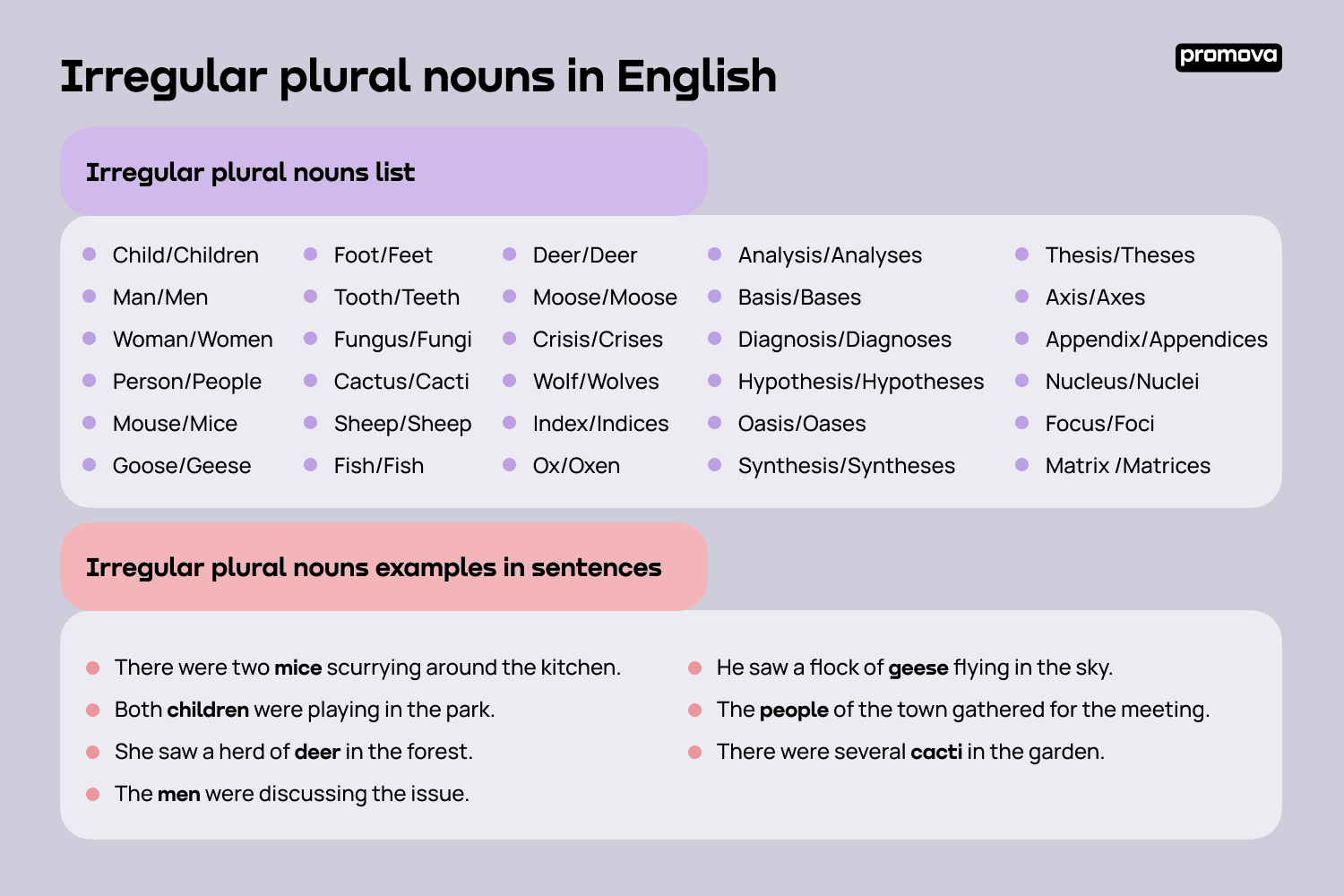Irregular plural nouns in English
Contents
Are you overwhelmed by irregular plural nouns and not quite sure how they work? Then this reference is for you! While they might be confusing at first, irregular plurals in English follow their own rules which are easy to grasp. You will soon learn to recognize, use, and form irregular plural nouns sentences without any trouble.
What is an irregular plural noun?
An irregular plural noun does not follow the standard rules of forming its plural form. Irregular plural nouns are often the same as the singular form or may have a different spelling or pronunciation, or even a completely different form.
For example, the singular noun 'mouse' becomes the irregular plural noun 'mice', and the singular noun 'child' becomes the irregular plural noun 'children'.
Irregular plural nouns often come from foreign languages, such as Latin or Greek, and usually don't follow the same rules as other nouns.
How to recognize irregular plural forms
The best way to recognize an irregular plural noun is to look at the word itself. They usually end in -es, -s, -ies, or -ves. For example, the word 'crisis' becomes 'crises' when pluralized, and the word 'wolf' becomes 'wolves'.
Another way to recognize an irregular plural noun is to look at the context in which it is used. If there are two or more nouns and they don't follow the same pattern of forming plurals (such as adding an -s), then it's likely that one of them is an irregular plural.
Finally, you can also use a dictionary or a full list of irregular nouns provided below. These will usually list out all forms of a word and its corresponding plural form.

Irregular plural nouns list
Here is a full list of some the most common irregular plural nouns in English:
- Child/Children
- Man/Men
- Woman/Women
- Person/People
- Mouse/Mice
- Goose/Geese
- Foot/Feet
- Tooth/Teeth
- Fungus/Fungi
- Cactus/Cacti
- Sheep/Sheep
- Fish/Fish
- Deer/Deer
- Moose/Moose
- Crisis/Crises
- Wolf/Wolves
- Index/Indices
- Ox/Oxen
- Analysis/Analyses
- Basis/Bases
- Diagnosis/Diagnoses
- Hypothesis/Hypotheses
- Oasis/Oases
- Synthesis/Syntheses
- Thesis/Theses
- Axis/Axes
- Appendix/Appendices
- Nucleus/Nuclei
- Focus/Foci
- Matrix /Matrices
1
Irregular plural nouns examples in sentences
Here are some examples of irregular plural nouns used in sentences:
- There were two mice scurrying around the kitchen.
- Both children were playing in the park.
- She saw a herd of deer in the forest.
- The men were discussing the issue.
- He saw a flock of geese flying in the sky.
- The people of the town gathered for the meeting.
- There were several cacti in the garden.
Rules of irregular plurals
Although there are no hard rules for forming irregular plural nouns, there are some patterns that can help you remember them.
- Some nouns just add an 's' at the end to form their plural form, such as 'man' to 'men'.
- Some nouns change their spelling completely, such as 'mouse' to 'mice'.
- Some nouns use the same form in both singular and plural, such as 'sheep' and 'fish'.
- Some nouns have a different ending depending on their origin, such as 'fungus' to 'fungi'.
Once you find and remember enough of these words, you will be able to remember the correct plural form of most irregular nouns based on these patterns.
Common mistakes
One of the most common mistakes that English learners make with irregular plural nouns is confusing them with regular nouns. The plural of 'man' is 'men' and not 'mans'. Similarly, the plural of 'woman' is 'women' and not 'womans'.
Similarly, the plural of 'person' is 'people' and not 'persons' although this form sometimes comes up when we refer to a number of individuals. Remember that some nouns share the same form in both singular and plural, such as 'sheep' and 'fish'.
Summary
In this reference, we have discussed irregular plural nouns in English. We have also seen a list of some of the most common irregular plural nouns, as well as examples of how to use them in sentences. We have also looked at some rules for forming irregular plural nouns, as well as some common mistakes that are often made with them.
While irregular plurals might sound confusing at first, with enough practice, you will soon be able to use them without any problems. Good luck on your learning journey!
Comments